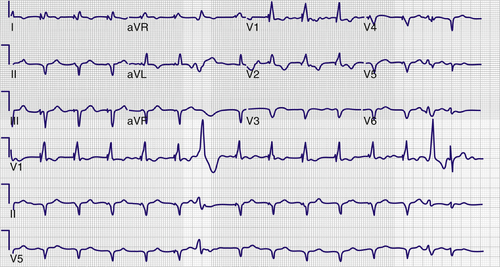History
A 58-year-old man with ischemic cardiomyopathy with an ejection fraction of 20%, a history of coronary artery bypass graft surgery in 1993, and placement of a biventricular defibrillator (Medtronic Concerto; Guidant 0185 RV ICD lead; Attain Starfix 4195 coronary venous lead) on October 25, 2007 for primary prevention, a history of a left ventricular thrombus, and persistent atrial fibrillation sought treatment at a hospital with fevers, chills, and worsening dyspnea on exertion occurring over the previous 2 months. On admission, blood cultures were drawn that were positive for methicillin-resistant Staphylococus aureus (MRSA). A transesophageal echocardiogram suggested a vegetation on the implantable cardioverter-defibrillator (ICD) lead, prompting transfer to a tertiary referral center for complete system extraction.
Comments
Cardiac implantable electronic device (CIED) infection is typically defined as the presence of local warmth, erythema, swelling, edema, pain, or discharge from the device pocket, along with a positive culture from the device, device pocket, blood, or lead. Device-associated endocarditis is defined as the presence of a lead or valvular vegetation on echocardiogram. Prompt removal of the CIED and all leads and administration of a prolonged course of antibiotics is the appropriate management for CIED-related infections. Lead extraction procedures must be performed only at facilities with cardiac surgery programs with experienced cardiac surgeons on site and ready to initiate emergency cardiac surgery. The facility to which this patient presented lacked such capability, making the transfer to a tertiary referral center with significant experience in lead extraction appropriate.
Current Medications
The patient was receiving vancomycin 1 g intravenously twice daily and heparin according to a drip rate nomogram; he was also taking carvedilol 6.25 mg orally twice daily, lisinopril 2.5 mg orally daily, omeprazole 20 mg orally daily, atorvastatin 20 mg orally daily at bedtime, and aspirin 81 mg orally daily.
Comments
Vancomycin is a first-line therapy for MRSA-related bloodstream infections. Staphylococcal species are responsible for 60% to 80% of CIED infections. The optimal duration of antimicrobial therapy for CIED infection is unclear. At least 2 weeks of intravenous antimicrobial therapy is recommended after extraction of an infected device for patients with infected CIED systems, but with positive blood cultures or vegetations the recommendation is usually 4 to 6 weeks. The patient’s heparin drip was stopped the night before the planned extraction.
Current Symptoms

Comments
In patients with a CIED infection, fevers and chills are often absent.
Physical Examination
Comments
In all patients thought to have a CIED infection, the device pocket should be inspected carefully for signs of erythema, fluctuance, and drainage. The absence of such signs, however, does not rule out CIED infection.
Laboratory Data
Comments
The patient’s white blood cell count was within normal limits. Many patients with CIED infection fail to present with significant leukocytosis.
Electrocardiogram
Findings
The preextraction electrocardiogram shows atrial fibrillation with a biventricular paced rhythm and occasional premature ventricular contractions (Figure 34-1).
Chest Radiograph
Findings
Portable chest radiography demonstrated the presence of a Medtronic 4195 Starfix coronary sinus lead in a midmyocardial position (Figure 34-2).
Echocardiogram



